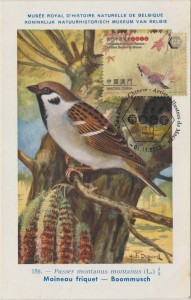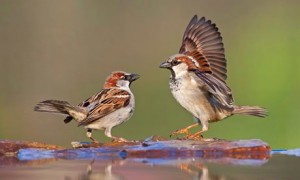Week 16 – 23 October 2016:
Irony in the World of Birds
It would probably be quicker to list all of the places where House Sparrows cannot be found. Native to Europe and large swathes of Asia, the Middle East and Africa, it has been successfully introduced to North and South America, the Caribbean, Australia, New Zealand, Hawaii, Mauritius and so on. Adaptable in the extreme, according to a 1993 book by Clement, Harris and Davis, “especially remarkable being the birds that lived and bred 640 m down a coal-mine in South Yorkshire, England, living on food provided by miners.” The closely-related Tree Sparrow also has a wide breeding distribution in Europe, Asia and the Middle East, and has been introduced to Sardinia, the United States, India, Indonesia, Hong Kong, Borneo, Australia, and, well, you get the picture.
Are you ready for some irony? Although there may be as many as 540 million House Sparrows in the world, and perhaps 570 million Tree Sparrows, significant population declines in some regions have caused concern. The British Trust for Ornithology estimates that the U.K. House Sparrow population has declined by half in recent decades, and the city of Edinburgh is said to have lost 90% of those birds between 1982 and 1998. What is going on?
Martin Šálek of the Academy of Sciences of the Czech Republic, and Jan Riegert and Stanislav Grill of the University of South Bohemia investigated House and Tree sparrows in the community of České Budějovice. With 94,000 inhabitants, it is the largest city in the Czech Republic’s South Bohemia region. Better known for its industry than its sparrows, České Budějovice is the home of Koh-i-Noor Hardtmuth pencils and the Budweiser Budvar brewery.
In May of 2013, Šálek and his crew documented every House and Tree sparrow and every nest within the 19.2 km2 (7.4 miles2) spread of the city. On foot and on bicycle, they travelled the city’s streets and parks, peeped over fences, and listened for diagnostic chirping. Dividing the city into 675 plots, each 200 by 200 m (10 acres), they noted the type of habitat found in each plot, including residential sites, parks and cemeteries, and industrial and commercial areas.
Šálek et al. recorded 2251 House Sparrows and 537 Tree Sparrows. House Sparrow densities were highest in residential areas, and were comparatively abundant in the city centre. “High” is a relative term in this case, and House Sparrow densities were much lower than in many other European cities. Tree Sparrows are less dependant on urban landscapes, preferring gardens to residential sites in České Budějovice, they were not seen in the city centre. It seemed “that both sparrows are associated with diverse and mixed habitat composition, where they can find suitable foraging and nesting conditions.” This is particularly true in the breeding season, when adults need to find insects to provide a protein-rich diet for their nestlings.
Even though they are quite flexible, both sparrows built the majority of their nests in crevices and holes in buildings. The older the building, the better. The modernization of old buildings is likely to result in population declines in these sparrows.
“Nesting opportunities could,” explained Šálek et al., “be improved by simple and cheap solutions.” In the reconstruction of old buildings, architects might allow for access for sparrow to nesting sites. New buildings could incorporate cavities for sparrows and other urban birds. Solutions to environmental problems are not always costly or complicated.
Šálek, M., J. Riegert and S. Grill. House Sparrows Passer domesticus and Tree Sparrows Passer montanus: fine-scale distribution, population densities, and habitat selection in a Central European city. Acta Ornithologica 50:221-232.
Photocredits: Eurasian Tree Sparrow stamp - philatelicbirds-art.blogspot.com.au; male House Sparrows - www.theguardian.com



